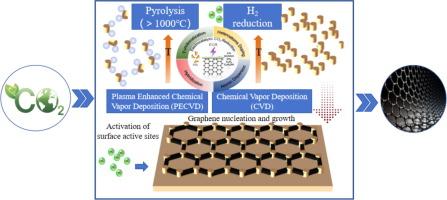二氧化碳的高附加值利用:二氧化碳制备石墨烯的材料、方法和前景
IF 9
1区 工程技术
Q1 ENGINEERING, CHEMICAL
引用次数: 0
摘要
由于对化石燃料的过度依赖,全球二氧化碳浓度迅速上升,使全球变暖、海平面上升和能源枯竭成为现代社会面临的最紧迫、最严峻的挑战。作为一种变革性材料,石墨烯有望为依赖化石燃料的经济体带来更可持续的未来。鉴于二氧化碳利用的附加值普遍较低,本文概述了以二氧化碳为前驱体和最终产物合成石墨烯的制备机理和催化条件。除了石墨烯的结构特性外,还评估了各种制备方法的优点和局限性,包括化学气相沉积(CVD),金热反应,熔盐碳捕获和电化学转化(MSCCET)。在高附加值的二氧化碳合成石墨烯中,催化剂性能、制备机制和形态控制的进步至关重要。此外,成本和环境评估也不容忽视。这项工作为推进二氧化碳的高附加值利用和石墨烯基材料的发展提供了有价值的见解。本文章由计算机程序翻译,如有差异,请以英文原文为准。

High value-added utilization of CO2: Materials, methods, and prospects for catalytic conversion of graphene prepared from CO2
The rapid rise in global CO2 levels, driven by excessive reliance on fossil fuels, has made global warming, sea-level rise, and energy depletion among the most urgent and critical challenges facing modern society. As a transformative material, graphene holds significant promise for enabling a more sustainable future for fossil fuel-dependent economies. Given the generally low added value of CO2 utilization, this paper outlines the preparation mechanisms and catalytic conditions for synthesizing graphene using CO2 as both a precursor and an end product. It also evaluates the advantages and limitations of various preparation methods, including chemical vapor deposition (CVD), the gold thermal reaction, and molten salt carbon capture and electrochemical transformation (MSCCET), alongside the structural properties of graphene. In the high-value-added synthesis of graphene from CO2, advancements in catalyst performance, preparation mechanisms, and morphological control are crucial. Additionally, cost and environmental assessments must not be overlooked. This work provides valuable insights for advancing the high-value-added utilization of CO2 and the development of graphene-based materials.
求助全文
通过发布文献求助,成功后即可免费获取论文全文。
去求助
来源期刊

Separation and Purification Technology
工程技术-工程:化工
CiteScore
14.00
自引率
12.80%
发文量
2347
审稿时长
43 days
期刊介绍:
Separation and Purification Technology is a premier journal committed to sharing innovative methods for separation and purification in chemical and environmental engineering, encompassing both homogeneous solutions and heterogeneous mixtures. Our scope includes the separation and/or purification of liquids, vapors, and gases, as well as carbon capture and separation techniques. However, it's important to note that methods solely intended for analytical purposes are not within the scope of the journal. Additionally, disciplines such as soil science, polymer science, and metallurgy fall outside the purview of Separation and Purification Technology. Join us in advancing the field of separation and purification methods for sustainable solutions in chemical and environmental engineering.
 求助内容:
求助内容: 应助结果提醒方式:
应助结果提醒方式:


